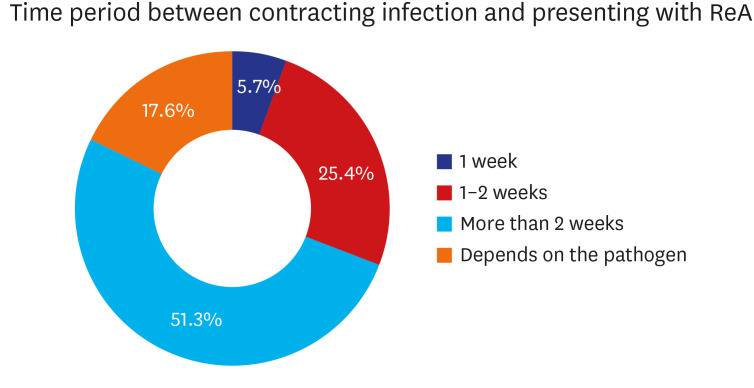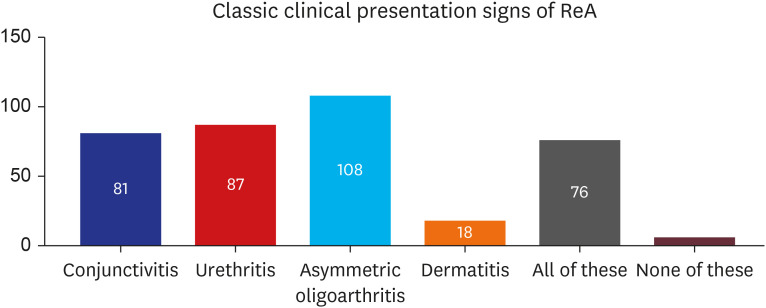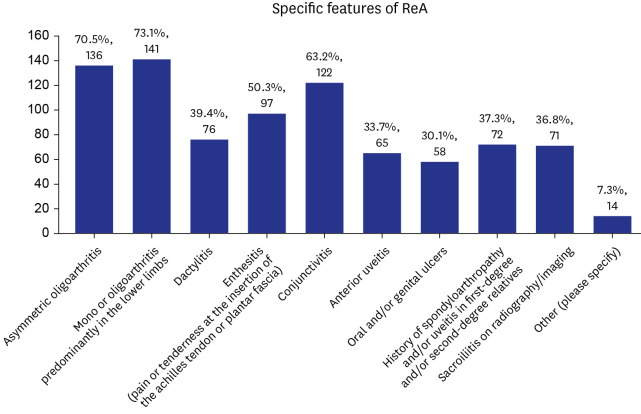J Korean Med Sci.
2022 Dec;37(50):e355. 10.3346/jkms.2022.37.e355.
Knowledge and Perceptions of Reactive Arthritis Diagnosis and Management Among Healthcare Workers During the COVID-19 Pandemic: Online Survey
- Affiliations
-
- 1Department of Biology and Biochemistry, South Kazakhstan Medical Academy, Shymkent, Kazakhstan
- 2Byramjee Jeejeebhoy Government Medical College and Sassoon General Hospitals, Pune, India
- 3Department of Clinical Immunology and Rheumatology, Sanjay Gandhi Postgraduate Institute of Medical Sciences, Lucknow, India
- 4Department of Rheumatology, Royal Wolverhampton Hospitals NHS Trust, Wolverhampton, UK
- 5Department of Rheumatology, City Hospital, Sandwell and West Birmingham Hospitals NHS Trust, Birmingham, UK
- 6Division of Musculoskeletal and Dermatological Sciences, Centre for Musculoskeletal Research, School of Biological Sciences, The University of Manchester, Manchester, UK
- 7Virgen Milagrosa University Foundation College of Medicine, San Carlos City, Pangasinan, Philippines
- 8Department of Internal Medicine #2, Danylo Halytsky Lviv National Medical University, Lviv, Ukraine
- 9Departments of Rheumatology and Research and Development, Dudley Group NHS Foundation Trust (Teaching Trust of the University of Birmingham, UK), Russells Hall Hospital, Dudley, UK
- 10Department of Clinical Immunology and Rheumatology, Kalinga Institute of Medical Sciences (KIMS), KIIT University, Bhubaneswar, India
- 11Centre for Epidemiology Versus Arthritis, University of Manchester, Manchester, UK
- KMID: 2537053
- DOI: http://doi.org/10.3346/jkms.2022.37.e355
Abstract
- Background
Reactive arthritis (ReA) is an often neglected disease that received some attention during the coronavirus disease 2019 (COVID-19) pandemic. There is some evidence that infection with severe acute respiratory syndrome coronavirus 2 can lead to “reactive” arthritis. However, this does not follow the classical definition of ReA that limits the organisms leading to this condition. Also, there is no recommendation by any international society on the management of ReA during the current pandemic. Thus, a survey was conducted to gather information about how modern clinicians across the world approach ReA.
Methods
An e-survey was carried out based on convenient sampling via social media platforms. Twenty questions were validated on the pathogenesis, clinical presentation, and management of ReA. These also included information on post-COVID-19 arthritis. Duplicate entries were prevented and standard guidelines were followed for reporting internet-based surveys.
Results
There were 193 respondents from 24 countries. Around one-fifth knew the classical definition of ReA. Nearly half considered the triad of conjunctivitis, urethritis and asymmetric oligoarthritis a “must” for diagnosis of ReA. Other common manifestations reported include enthesitis, dermatitis, dactylitis, uveitis, and oral or genital ulcers. Threefourths opined that no test was specific for ReA. Drugs for ReA were non-steroidal antiinflammatory drugs, intra-articular injections, and conventional disease-modifying agents with less than 10% supporting biological use.
Conclusion
The survey brought out the gap in existing concepts of ReA. The current definition needs to be updated. There is an unmet need for consensus recommendations for the management of ReA, including the use of biologicals.
Keyword
Figure
Cited by 1 articles
-
GPTZero Performance in Identifying Artificial Intelligence-Generated Medical Texts: A Preliminary Study
Farrokh Habibzadeh
J Korean Med Sci. 2023;38(38):e319. doi: 10.3346/jkms.2023.38.e319.
Reference
-
1. Avouac J, Drumez E, Hachulla E, Seror R, Georgin-Lavialle S, El Mahou S, et al. COVID-19 outcomes in patients with inflammatory rheumatic and musculoskeletal diseases treated with rituximab: a cohort study. Lancet Rheumatol. 2021; 3(6):e419–e426. PMID: 33786454.2. Chattopadhyay A, Mishra D, Sharma V, Naidu GSK, Sharma A. Coronavirus disease-19 and rheumatological disorders: a narrative review. Indian J Rheumatol. 2020; 15(2):122–129.3. Williamson EJ, Walker AJ, Bhaskaran K, Bacon S, Bates C, Morton CE, et al. Factors associated with COVID-19-related death using OpenSAFELY. Nature. 2020; 584(7281):430–436. PMID: 32640463.4. Cordtz R, Lindhardsen J, Soussi BG, Vela J, Uhrenholt L, Westermann R, et al. Incidence and severeness of COVID-19 hospitalization in patients with inflammatory rheumatic disease: a nationwide cohort study from Denmark. Rheumatology (Oxford). 2021; 60(SI):SI59–SI67. PMID: 33369663.5. D’Silva KM, Jorge A, Cohen A, McCormick N, Zhang Y, Wallace ZS, et al. COVID-19 outcomes in patients with systemic autoimmune rheumatic diseases compared to the general population: a US multicenter, comparative cohort study. Arthritis Rheumatol. 2021; 73(6):914–920. PMID: 33305544.6. Gianfrancesco M, Hyrich KL, Al-Adely S, Carmona L, Danila MI, Gossec L, et al. Characteristics associated with hospitalisation for COVID-19 in people with rheumatic disease: data from the COVID-19 Global Rheumatology Alliance physician-reported registry. Ann Rheum Dis. 2020; 79(7):859–866. PMID: 32471903.7. Peach E, Rutter M, Lanyon P, Grainge MJ, Hubbard R, Aston J, et al. Risk of death among people with rare autoimmune diseases compared with the general population in England during the 2020 COVID-19 pandemic. Rheumatology (Oxford). 2021; 60(4):1902–1909. PMID: 33271595.8. Raiker R, Pakhchanian H, Kavadichanda C, Gupta L, Kardeş S, Ahmed S. Axial spondyloarthritis may protect against poor outcomes in COVID-19: propensity score matched analysis of 9766 patients from a nationwide multi-centric research network. Clin Rheumatol. 2022; 41(3):721–730. PMID: 34837569.9. Kocyigit BF, Akyol A. Reactive arthritis after COVID-19: a case-based review. Rheumatol Int. 2021; 41(11):2031–2039. PMID: 34550429.10. Bekaryssova D, Yessirkepov M, Zimba O, Gasparyan AY, Ahmed S. Reactive arthritis before and after the onset of the COVID-19 pandemic. Clin Rheumatol. 2022; 41(6):1641–1652. PMID: 35247132.11. Gupta P, Kharbanda R, Abbasi M, Raj R, Gupta L. Individuals with reactive arthritis suffer from poor health-related quality of life akin to individuals with ankylosing spondylitis: a multigroup study. Indian J Rheumatol. 2022; 17(2):110–117.12. Jubber A, Moorthy A. Reactive arthritis: a clinical review. J R Coll Physicians Edinb. 2021; 51(3):288–297. PMID: 34528623.13. Selmi C, Gershwin ME. Diagnosis and classification of reactive arthritis. Autoimmun Rev. 2014; 13(4-5):546–549. PMID: 24418301.14. Kim HA, Lee E, Park SY, Lee SS, Shin K. Clinical characteristics of patients with psoriatic spondylitis versus those with ankylosing spondylitis: features at baseline before biologic therapy. J Korean Med Sci. 2022; 37(33):e253. PMID: 35996930.15. Misra R, Gupta L. Epidemiology: time to revisit the concept of reactive arthritis. Nat Rev Rheumatol. 2017; 13(6):327–328. PMID: 28490789.16. Henrique da Mota LM, Carneiro JN, Lima RA, dos Santos Neto LL, Lima FA. Reactive arthritis in HIV-infected patients: immunopathogenic aspects. Acta Reumatol Port. 2008; 33(3):279–287. PMID: 18846008.17. Schett G, Manger B, Simon D, Caporali R.. COVID-19 revisiting inflammatory pathways of arthritis. Nat Rev Rheumatol. 2020; 16(8):465–470. PMID: 32561873.18. Hyun H, Song JY, Seong H, Yoon JG, Noh JY, Cheong HJ, et al. Polyarthralgia and myalgia syndrome after ChAdOx1 nCOV-19 vaccination. J Korean Med Sci. 2021; 36(34):e245. PMID: 34463066.19. Bekaryssova D, Yessirkepov M, Zimba O, Gasparyan AY, Ahmed S. Revisiting reactive arthritis during the COVID-19 pandemic. Clin Rheumatol. 2022; 41(8):2611–2612. PMID: 35796848.20. Gaur PS, Zimba O, Agarwal V, Gupta L. Reporting survey based studies - a primer for authors. J Korean Med Sci. 2020; 35(45):e398. PMID: 33230988.21. Eysenbach G. Improving the quality of Web surveys: the Checklist for Reporting Results of Internet E-Surveys (CHERRIES). J Med Internet Res. 2004; 6(3):e34. PMID: 15471760.22. Cheeti A, Chakraborty RK, Ramphul K. Reactive arthritis. StatPearls. Treasure Island, FL, USA: StatPearls Publishing;2022.23. Taniguchi Y, Nishikawa H, Yoshida T, Terada Y, Tada K, Tamura N, et al. Expanding the spectrum of reactive arthritis (ReA): classic ReA and infection-related arthritis including poststreptococcal ReA, Poncet’s disease, and iBCG-induced ReA. Rheumatol Int. 2021; 41(8):1387–1398. PMID: 33939015.24. Zeidler H, Hudson AP. Quo vadis reactive arthritis? Curr Opin Rheumatol. 2022; 34(4):218–224. PMID: 35699331.25. Zeidler H, Hudson AP. Reactive arthritis update: spotlight on new and rare infectious agents implicated as pathogens. Curr Rheumatol Rep. 2021; 23(7):53. PMID: 34196842.26. Wendling D, Prati C, Chouk M, Verhoeven F. Reactive arthritis: treatment challenges and future perspectives. Curr Rheumatol Rep. 2020; 22(7):29. PMID: 32458153.27. Braun J, Kingsley G, van der Heijde D, Sieper J. On the difficulties of establishing a consensus on the definition of and diagnostic investigations for reactive arthritis. Results and discussion of a questionnaire prepared for the 4th International Workshop on Reactive Arthritis, Berlin, Germany, July 3-6, 1999. J Rheumatol. 2000; 27(9):2185–2192. PMID: 10990232.28. Ahmed S, Anirvan P. Top central asian educational institutions on Publons: analysis of researchers and reviewers. J Korean Med Sci. 2021; 36(21):e144. PMID: 34060259.29. Gasparyan AY, Ayvazyan L, Mukanova U, Yessirkepov M, Kitas GD. Scientific hypotheses: writing, promoting, and predicting implications. J Korean Med Sci. 2019; 34(45):e300. PMID: 31760713.
- Full Text Links
- Actions
-
Cited
- CITED
-
- Close
- Share
- Similar articles
-
- Assessment and Management of Dysphagia during the COVID-19 Pandemic
- Burnout among Healthcare Workers during COVID-19 Pandemic
- Pandemic Pressure: Changes in Hypertensive Management Adherence in Indonesia
- Insights and pearls of healthcare systems management of COVID-19 in Asia and its relevance to Asian transplant services
- The Management of Thyroid Disease in COVID-19 Pandemic





